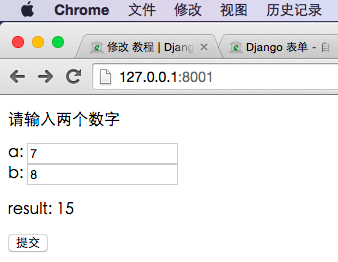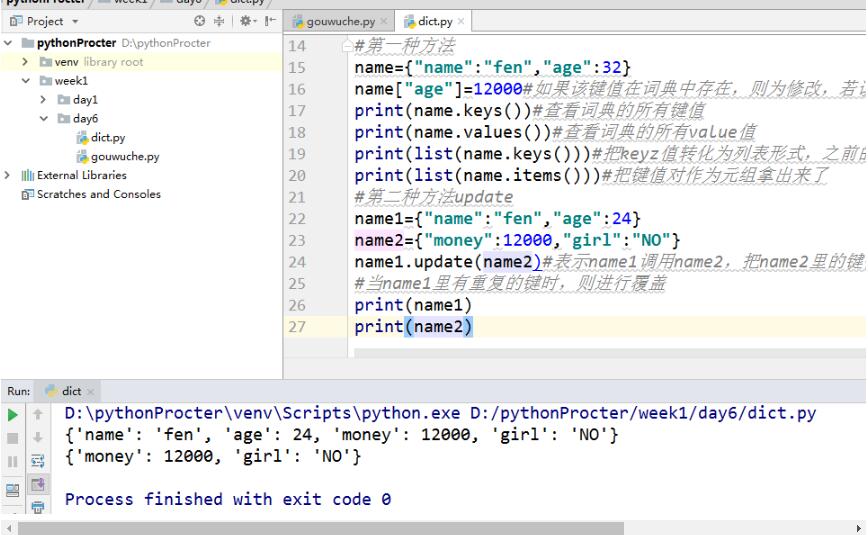Django与JS交互的示例代码
应用一:有时候我们想把一个 list 或者 dict 传递给 javascript,处理后显示到网页上,比如要用 js 进行可视化的数据。
请注意:如果是不处理,直接显示在网页上,用Django模板就可以了。
这里讲述两种方法:
一,页面加载完成后,在页面上操作,在页面上通过 ajax 方法得到新的数据(再向服务器发送一次请求)并显示在网页上,这种情况适用于页面不刷新的情况下,动态加载一些内容。比如用户输入一个值或者点击某个地方,动态地把相应内容显示在网页上。
二,直接在视图函数(views.py中的函数)中渲染一个 list 或 dict 的内容,和网页其它部分一起显示到网页上(一次性地渲染,还是同一次请求)。
需要注意两点:1、views.py中返回的函数中的值要用 json.dumps()处理 2、在网页上要加一个 safe 过滤器
view.py
# -*- coding: utf-8 -*-
from __future__ import unicode_literals
import json
from django.shortcuts import render
def home(request):
List = ['自强学堂', '渲染Json到模板']
Dict = {'site': '自强学堂', 'author': '涂伟忠'}
return render(request, 'home.html', {
'List': json.dumps(List),
'Dict': json.dumps(Dict)
})
home.html
<!DOCTYPE html>
<html>
<head>
<title>欢迎光临 自强学堂!</title>
<script src="http://apps.bdimg.com/libs/jquery/1.10.2/jquery.min.js"></script>
</head>
<body>
<div id="list"> 学习 </div>
<div id='dict'></div>
<script type="text/javascript">
//列表
var List = {{ List|safe }};
//下面的代码把List的每一部分放到头部和尾部
$('#list').prepend(List[0]);
$('#list').append(List[1]);
console.log('--- 遍历 List 方法 1 ---')
for(i in List){
console.log(i);// i为索引
}
console.log('--- 遍历 List 方法 2 ---')
for (var i = List.length - 1; i >= 0; i--) {
// 鼠标右键,审核元素,选择 console 可以看到输入的值。
console.log(List[i]);
};
console.log('--- 同时遍历索引和内容,使用 jQuery.each() 方法 ---')
$.each(List, function(index, item){
console.log(index);
console.log(item);
});
// 字典
var Dict = {{ Dict|safe }};
console.log("--- 两种字典的取值方式 ---")
console.log(Dict['site']);
console.log(Dict.author);
console.log("--- 遍历字典 ---");
for(i in Dict) {
console.log(i + Dict[i]);//注意,此处 i 为键值
}
</script>
</body>
</html>
应用二:不刷新网页的情况下,加载一些内容
view.py
#coding:utf-8
from __future__ import unicode_literals
from django.shortcuts import render
from django.http import HttpResponse
def get(request):
return render(request, 'oneapp/get.html')
def add(request):
a = request.GET.get('a', 0)
b = request.GET.get('b', 0)
c = int(a) + int(b)
return HttpResponse(str(c))
urls.py
from django.conf.urls import url, include from django.contrib import admin from OneApp import views as oneapp_views urlpatterns = [ url(r'^admin/', admin.site.urls), #url(r'^$', oneapp_views.index), url(r'^oneapp/index/', oneapp_views.index, name='index'), url(r'^oneapp/home/', oneapp_views.home, name='home'), url(r'^oneapp/get/', oneapp_views.get, name='get'), url(r'^oneapp/add/', oneapp_views.add, name='add'), ]
get.html
<!DOCTYPE html>
<html>
<body>
<p>请输入两个数字</p>
<form action="/oneapp/add/" method="get">
a: <input type="text" id="a" name="a"> <br>
b: <input type="text" id="b" name="b"> <br>
<p>result: <span id='result'></span></p>
<button type="button" id='sum'>提交</button>
</form>
<script src="http://apps.bdimg.com/libs/jquery/1.11.1/jquery.min.js"></script>
<script>
$(document).ready(function(){
$("#sum").click(function(){
var a = $("#a").val();
var b = $("#b").val();
$.get("/oneapp/add/",{'a':a,'b':b}, function(ret){
$('#result').html(ret)
})
});
});
</script>
</body>
</html>
由于用 jQuery 实现 ajax 比较简单,所以我们用 jQuery库来实现.。
用了jQuery.get() 方法,并用 $(selector).html() 方法将结果显示在页面上,如下图:

应用三:传递数字或者字典到网页,由JS处理,再显示出来
首先定义接口和URL
views.py
#coding:utf-8
from __future__ import unicode_literals
from django.shortcuts import render
from django.http import HttpResponse, JsonResponse
import json
# Create your views here.
def ajax_list(request):
a = range(100)
#return HttpResponse(json.dump(a), content_type='application/json')
return JsonResponse(a, safe=False)
def ajax_dict(request):
name_dict = {'a': 1, 'b': 2}
#return HttpResponse(json.dump(name_dict), content_type='application/json')
return JsonResponse(name_dict)
urls.py
urlpatterns = [ url(r'^admin/', admin.site.urls), #url(r'^$', oneapp_views.index), url(r'^oneapp/index/', oneapp_views.index, name='index'), url(r'^oneapp/home/', oneapp_views.home, name='home'), url(r'^oneapp/get/', oneapp_views.get, name='get'), url(r'^oneapp/add/', oneapp_views.add, name='add'), url(r'^oneapp/ajax_list/', oneapp_views.ajax_list, name='ajax_list'), url(r'^oneapp/ajax_dict/', oneapp_views.ajax_dict, name='ajax_dict'), ]
然后就是在无刷新的情况下,把内容加载到页面了。
index.html
<!DOCTYPE html>
<html>
<body>
<p>请输入两个数字</p>
<form action="/add/" method="get">
a: <input type="text" id="a" name="a"> <br>
b: <input type="text" id="b" name="b"> <br>
<p>result: <span id='result'></span></p>
<button type="button" id='sum'>提交</button>
</form>
<div id="dict">Ajax 加载字典</div>
<p id="dict_result"></p>
<div id="list">Ajax 加载列表</div>
<p id="list_result"></p>
<script src="http://apps.bdimg.com/libs/jquery/1.11.1/jquery.min.js"></script>
<script>
$(document).ready(function(){
// 求和 a + b
$("#sum").click(function(){
var a = $("#a").val();
var b = $("#b").val();
$.get("{% url 'add' %}",{'a':a,'b':b}, function(ret){
$('#result').html(ret);
})
});
// 列表 list
$('#list').click(function(){
$.getJSON("{% url 'ajax_list' %}",function(ret){
//返回值 ret 在这里是一个列表
for (var i = ret.length - 1; i >= 0; i--) {
// 把 ret 的每一项显示在网页上
$('#list_result').append(' ' + ret[i])
};
})
})
// 字典 dict
$('#dict').click(function(){
$.getJSON("{% url 'ajax_dict' %}",function(ret){
//返回值 ret 在这里是一个字典
$('#dict_result').append(ret.a + '<br>');
// 也可以用 ret['twz']
})
})
});
</script>
</body>
</html>
注意:getJSON中的写的对应网址,用 urls.py 中的 name 来获取是一个更好的方法!标签:{% url 'name' %}
这样做最大的好处就是在修改 urls.py 中的网址后,不用改模板中对应的网址。
如果是一个复杂的字典或者列表,如:
person_info_dict = [
{"name":"xiaoming", "age":20},
{"name":"tuweizhong", "age":24},
{"name":"xiaoli", "age":33},
]
这样我们遍历列表的时候,每次遍历得到一个字典,再用字典的方法去处理,当然有更简单的遍历方法:
用 $.each() 方法代替 for 循环,html 代码(jquery)
$.getJSON('ajax_url_to_json', function(ret) {
$.each(ret, function(i,item){
// i 为索引,item为遍历值
});
});
补充:如果 ret 是一个字典,$.each 的参数有所不同,详见:http://api.jquery.com/jquery.each/
$.getJSON('ajax-get-a-dict', function(ret) {
$.each(ret, function(key, value){
// key 为字典的 key,value 为对应的值
});
});
以上就是本文的全部内容,希望对大家的学习有所帮助,也希望大家多多支持【听图阁-专注于Python设计】。
